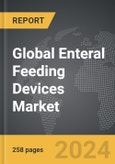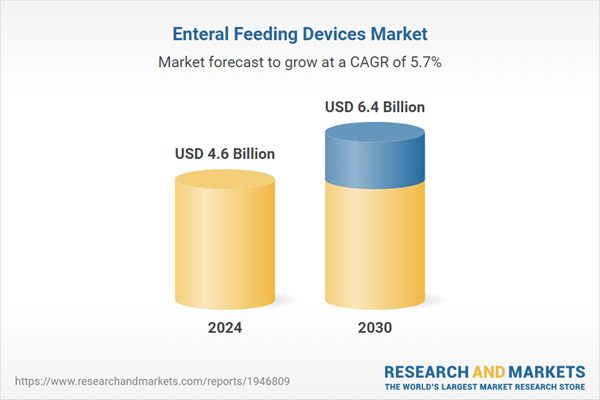The global market for Enteral Feeding Devices was valued at US$4.6 Billion in 2024 and is projected to reach US$6.4 Billion by 2030, growing at a CAGR of 5.7% from 2024 to 2030. This comprehensive report provides an in-depth analysis of market trends, drivers, and forecasts, helping you make informed business decisions. The report includes the most recent global tariff developments and how they impact the Enteral Feeding Devices market.Preference for Enteral Nutrition over Parenteral Nutrition Bodes Well
Global Enteral Feeding Devices Market - Key Trends & Drivers Summarized
How Enteral Feeding Devices Are Advancing Patient Care Worldwide
Enteral feeding devices are essential in treating individuals with conditions such as neurological disorders, cancers, gastrointestinal diseases, and critical injuries. The global market for enteral feeding devices is undergoing significant expansion, driven by rising incidences of chronic illnesses, aging populations, and a growing demand for home-based healthcare solutions. Advances in device design - such as improved safety features, reduced infection risks, and better patient comfort - are making enteral feeding more accessible and manageable across care settings.A prominent trend shaping the market is the increasing preference for percutaneous endoscopic gastrostomy (PEG) and jejunostomy feeding tubes over nasogastric tubes, especially for long-term nutrition. This shift is due to the reduced risk of aspiration and better patient compliance associated with PEG tubes. Moreover, digital integration is emerging as a game-changer in enteral nutrition management. Smart pumps with real-time monitoring capabilities, alarm systems, and automated flow adjustments are being adopted in hospitals and home care settings to enhance precision and reduce the burden on caregivers. Additionally, the growing focus on pediatric and geriatric nutrition is expanding the market landscape, with tailored device designs and formulations now addressing unique patient needs across age groups.
How Are Clinical Practices and Care Models Reshaping Demand?
The demand for enteral feeding devices is being reshaped by evolving healthcare delivery models, particularly the transition toward outpatient and home-based care. As hospitals seek to reduce readmissions and manage capacity, patients requiring long-term nutritional support are increasingly discharged with enteral feeding systems for home use. This trend is driving innovations in user-friendly device interfaces, compact feeding pumps, and portable kits designed for non-clinical environments. Healthcare providers are placing greater emphasis on patient and caregiver education, further supporting the shift to decentralized care without compromising outcomes.In clinical settings, enhanced protocols around infection control and enteral nutrition administration are leading to increased adoption of closed system feeding solutions, which minimize exposure and reduce the risk of contamination. Interdisciplinary nutrition support teams are playing a critical role in optimizing feeding regimens and device selection, integrating evidence-based guidelines to enhance patient recovery and nutritional outcomes. In surgical and critical care units, enteral feeding is often initiated within 24 to 48 hours of admission, underscoring its importance in recovery strategies. These evolving clinical practices are not only improving patient care but also sustaining demand for advanced and reliable enteral feeding systems.
Which Patient Segments and Use Cases Are Driving the Market?
Several patient populations are contributing to the growth and diversification of the enteral feeding devices market. The geriatric population, which is more prone to conditions like stroke, dementia, and dysphagia, represents a significant segment requiring long-term enteral nutrition. Patients with cancer - particularly head, neck, and gastrointestinal cancers - also depend heavily on feeding devices during treatment and recovery. Neurological conditions such as ALS, cerebral palsy, and traumatic brain injuries necessitate sustained enteral support, driving the need for customized feeding solutions with enhanced safety and minimal discomfort.Pediatric applications are also gaining momentum, especially in managing congenital anomalies, premature births, and metabolic disorders. Devices tailored for children, with smaller sizes and gentle materials, are increasingly being adopted in neonatal and pediatric intensive care units. Furthermore, patients undergoing bariatric surgeries or those with malabsorptive disorders are being supported with enteral nutrition to stabilize metabolic functions post-surgery. This diverse patient base is broadening the market scope and driving manufacturers to innovate across device categories - ranging from feeding tubes and pumps to accessories like connectors and syringe sets.
What’ s Fueling the Growth in the Enteral Feeding Devices Market?
The growth in the enteral feeding devices market is driven by several factors
linked to technological innovation, changing patient demographics, and shifting care delivery models. First, the rising prevalence of chronic diseases - particularly neurological and gastrointestinal disorders - is fueling sustained demand for enteral nutrition across hospitals, long-term care centers, and home healthcare. Second, advancements in device technology, such as the development of low-profile tubes, antimicrobial materials, and automated feeding pumps, are making enteral feeding safer, more effective, and patient-friendly.Third, the global shift toward home healthcare, supported by healthcare policy reforms and payer incentives, is significantly boosting the adoption of portable and easy-to-use devices. Growing awareness and early diagnosis of malnutrition in both developed and developing countries are leading to increased intervention through enteral feeding. Another driver is the growing focus on value-based healthcare, which prioritizes improved patient outcomes and cost-efficiency - areas where enteral nutrition demonstrates clear benefits. Finally, innovations in tube placement techniques, better compatibility with nutritional formulations, and device standardization initiatives (such as ENFit connectors to prevent misconnections) are contributing to a safer, more compliant, and increasingly indispensable clinical toolset. Together, these drivers are positioning enteral feeding devices as vital components of modern healthcare systems worldwide.
Report Scope
The report analyzes the Enteral Feeding Devices market, presented in terms of market value. The analysis covers the key segments and geographic regions outlined below.- Segments: Type (Enteral Feeding Tubes, Administration Sets, Enteral Feeding Tubes, Enteral Syringes, Consumables); Application (Oncology, Gastrointestinal Diseases, Neurological Disorders Diabetes, Hypermetabolism, Other Applications); End-Use (Hospitals, Ambulatory Care Settings, Home Care Settings).
- Geographic Regions/Countries: World; United States; Canada; Japan; China; Europe (France; Germany; Italy; United Kingdom; Spain; Russia; and Rest of Europe); Asia-Pacific (Australia; India; South Korea; and Rest of Asia-Pacific); Latin America (Argentina; Brazil; Mexico; and Rest of Latin America); Middle East (Iran; Israel; Saudi Arabia; United Arab Emirates; and Rest of Middle East); and Africa.
Key Insights:
- Market Growth: Understand the significant growth trajectory of the Enteral Feeding Tubes segment, which is expected to reach US$3.5 Billion by 2030 with a CAGR of a 5.8%. The Administration Sets segment is also set to grow at 6.9% CAGR over the analysis period.
- Regional Analysis: Gain insights into the U.S. market, valued at $1.2 Billion in 2024, and China, forecasted to grow at an impressive 8.7% CAGR to reach $1.5 Billion by 2030. Discover growth trends in other key regions, including Japan, Canada, Germany, and the Asia-Pacific.
Why You Should Buy This Report:
- Detailed Market Analysis: Access a thorough analysis of the Global Enteral Feeding Devices Market, covering all major geographic regions and market segments.
- Competitive Insights: Get an overview of the competitive landscape, including the market presence of major players across different geographies.
- Future Trends and Drivers: Understand the key trends and drivers shaping the future of the Global Enteral Feeding Devices Market.
- Actionable Insights: Benefit from actionable insights that can help you identify new revenue opportunities and make strategic business decisions.
Key Questions Answered:
- How is the Global Enteral Feeding Devices Market expected to evolve by 2030?
- What are the main drivers and restraints affecting the market?
- Which market segments will grow the most over the forecast period?
- How will market shares for different regions and segments change by 2030?
- Who are the leading players in the market, and what are their prospects?
Report Features:
- Comprehensive Market Data: Independent analysis of annual sales and market forecasts in US$ Million from 2024 to 2030.
- In-Depth Regional Analysis: Detailed insights into key markets, including the U.S., China, Japan, Canada, Europe, Asia-Pacific, Latin America, Middle East, and Africa.
- Company Profiles: Coverage of players such as Advanced Data Systems Corporation (ADS), Allscripts Healthcare Solutions, Inc., AltexSoft, Annexus Health, Athenahealth, Inc. and more.
- Complimentary Updates: Receive free report updates for one year to keep you informed of the latest market developments.
Some of the 11 companies featured in this Enteral Feeding Devices market report include:
- ALCOR Scientific Inc.
- Amsino International Inc.
- Applied Medical Technology Inc.
- B. Braun Melsungen AG
- Boston Scientific Corporation
- Caesarea Medical Electronics Ltd.
- CONMED Corporation
- Cook Medical Inc.
- Fresenius KABI AG
- Halyard Health, Inc.
- Medela LLC
- Medtronic plc
- Moog Inc.
- Nestlé Health Science S.A
- Nutricia Advanced Medical Nutrition
- VYGON SA
This edition integrates the latest global trade and economic shifts into comprehensive market analysis. Key updates include:
- Tariff and Trade Impact: Insights into global tariff negotiations across 180+ countries, with analysis of supply chain turbulence, sourcing disruptions, and geographic realignment. Special focus on 2025 as a pivotal year for trade tensions, including updated perspectives on the Trump-era tariffs.
- Adjusted Forecasts and Analytics: Revised global and regional market forecasts through 2030, incorporating tariff effects, economic uncertainty, and structural changes in globalization. Includes historical analysis from 2015 to 2023.
- Strategic Market Dynamics: Evaluation of revised market prospects, regional outlooks, and key economic indicators such as population and urbanization trends.
- Innovation & Technology Trends: Latest developments in product and process innovation, emerging technologies, and key industry drivers shaping the competitive landscape.
- Competitive Intelligence: Updated global market share estimates for 2025, competitive positioning of major players (Strong/Active/Niche/Trivial), and refined focus on leading global brands and core players.
- Expert Insight & Commentary: Strategic analysis from economists, trade experts, and domain specialists to contextualize market shifts and identify emerging opportunities.
Table of Contents
Companies Mentioned (Partial List)
A selection of companies mentioned in this report includes, but is not limited to:
- ALCOR Scientific Inc.
- Amsino International Inc.
- Applied Medical Technology Inc.
- B. Braun Melsungen AG
- Boston Scientific Corporation
- Caesarea Medical Electronics Ltd.
- CONMED Corporation
- Cook Medical Inc.
- Fresenius KABI AG
- Halyard Health, Inc.
- Medela LLC
- Medtronic plc
- Moog Inc.
- Nestlé Health Science S.A
- Nutricia Advanced Medical Nutrition
- VYGON SA
Table Information
| Report Attribute | Details |
|---|---|
| No. of Pages | 258 |
| Published | December 2025 |
| Forecast Period | 2024 - 2030 |
| Estimated Market Value ( USD | $ 4.6 Billion |
| Forecasted Market Value ( USD | $ 6.4 Billion |
| Compound Annual Growth Rate | 5.7% |
| Regions Covered | Global |









